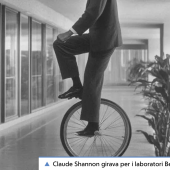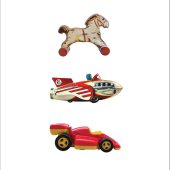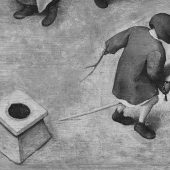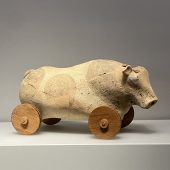Crete gets a direct mention in Toy Theory through the mythical automaton Talos. Constructed by the smith god Hephaestus, this giant bronze warrior patrolled the island’s coast (pictured here), defending it from attack by hurling rocks at hostile ships. There seem to be very few visual representations of Talos, with none in the Archaeological Museum in Chania, and Google turning up little more than a coin with a winged figure (c.300 BCE), and a column-krater with a painting of his defeat by Argonauts (c.450 BCE). There is a small park named after him near Chania’s Venetian harbour. None of these traces give a sense of either his metal construction or his giant scale. For a depiction worthy of this Bronze Age robot we have to turn to Ray Harryhausen’s animated special effects in the 1963 film Jason and the Argonauts.
Talos features in Toy Theory’s chapter on robots, in which I tease out toys and automata from a tangle of genealogical threads and technological imaginaries. My discussion of him relies on Adrienne Mayor’s wonderful book Gods and Robots: myths, machines and ancient dreams of technology (2018). There is a wealth of historical and critical literature on automata that note both their toy-like characteristics and their remarkable propensity to embody contemporaneous technological paradigms and imaginaries (my co-authored book, New Media: a critical introduction (Lister et al 2009) is the best starting point). Actual ancient automata were powered by hydraulics or steam, the eighteenth century’s clockwork-figured cosmology was epitomised in the programmable androids of Vaucanson and the Jacquet-Droz family, and from the late twentieth century information technology, cybernetics and genetic manipulation are realised and allegorised in robots, cellular automata, software agents, bots, videogame NPCs and Artificial Intelligence.
From this perspective, Talos was a phantasmagorical expression of a Bronze Age technological imaginary. In form, material, workings, and processes of manufacture Talos was rooted in the actual technics of his time, extrapolated through divine intervention into fully realising his imaginary potential. Hephaestus himself did not simply will his creations into being through divine power, he physically forged, cast and assembled them, and Talos’ powers of animation and autonomous behaviour were possible due to the tube of ichor that ran through his hollow body. Ichor is a divine substance – the blood of the gods, but is figured as the primary transformative material of the Bronze Age: molten metal.
Strictly speaking though, automata as self-moving entities are not allegories of their respective technological paradigms, but synecdochical of them: made from the same materials and mechanisms and rendered toy-like in their scale and manipulability (this is a key argument about the technocultural significance of toys that runs through Toy Theory).
But, why is it important to assert that automata are toys? Toy-like attributes are more consistent in automata than would first appear and go to the heart of their experimental, simulacral and performative character. Even those with natural-philosophical and scientific pretensions are characterised by a playfulness, a spectacular, wondrous or quasi-magical mode of presentation and public reception, revelling in the marvellousness of artifice and technical ingenuity.
Here are four ways that the automaton overlaps the toy. The first addresses the practical and the technical: the toy is the most suitable technocultural form for the embodiment, instantiation and public demonstration of new technologies, material forces, and their relationships. A toy is a concentration or condensation of materials, ideas, aesthetics, forces and mechanisms into a figure easily grasped by the hand, eye and imagination.
Second, these are highly sophisticated and expensive machines, but ones with no straightforward instrumental end: they are generative of knowledge, wonder and reflection but not of power or goods – luxurious and useless, they resonate with toy-like aspects of consumer culture to follow in the nineteenth century.
Third, they epitomise the uniquely toyetic epistemological mode that tracks throughout Toy Theory: a hands-on, material and mechanical instantiation of the thought experiment: a cognitive, imaginative and speculative what if? ‘OK,’ we might ponder,’ ‘this here-and-now marvellous machine doesn’t think, but our operation of it helps us imagine one that might, and to muse on what an actually thinking machine would entail.’
Finally, this toyetic mode of speculative knowledge manifests in two overlapping ways, the speculative (the what if? as above) and the deceptive. Figural automata are deceitful in their human- or animal-shaped forms; they appear natural and living but are synthetic and mechanical. Others play more elaborate trickery: promising displays of self-moving wonder whilst teasing their – more or less knowing – audiences with hints at the illusion. As a mode of cognition then, one’s apprehension of the automaton, like that of the toy, cannot be easily separated into comprehension and wonder, inquiry and credulity, knowledge and belief.




